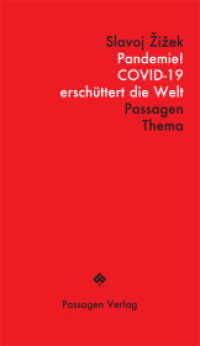- ホーム
- > 洋書
- > 英文書
- > History / World
Full Description
Teaching and learning through Hollywood, or commercial, film productions is anything but a new approach and has been something of a mainstay in the classroom for nearly a century. Purposeful and effective instruction through film, however, is not problem-free and there are many challenges that accompany classroom applications of Hollywood motion pictures. In response to the problems and possibilities associated with teaching through film, we have collaboratively developed a collection of practical, classroom-ready lesson ideas that might bridge gaps between theory and practice and assist teachers endeavoring to make effective use of film in their classrooms. We believe that film can serve as a powerful tool in the social studies classroom and, where appropriately utilized, foster critical thinking and civic mindedness.
The College, Career, and Civic Life (C3) framework, represents a renewed and formalized emphasis on the perennial social studies goals of deep thinking, reading and writing. We believe that as teachers endeavor to digest and implement the platform in schools and classrooms across the country, the desire for access to structured strategies that lead to more active and rigorous investigation in the social studies classroom will grow increasingly acute. Our hope is that this edited book might play a small role in the larger project of supporting practitioners, specifically K-12 teachers of United States history, by offering a collection of classroom-ready tools based on the Hollywood or History? strategy and designed to foster historical inquiry through the careful use of historically themed motion pictures. The book consists of K-5 and 6-12 lesson plans addressing the following historical eras (Adapted from: UCLA, National Center for History in Schools).
Contents
Problems and Possibilities of Teaching with Film.
Part I. Beginnings to 1620.
Chapter 1. Debunking Myths in U.S. History: Will the Real Story of Pocahontas Please Rise? Nancy Sardone.
Chapter 2. The New World, Gender Roles, and Issues of Point-of-View; Anne Perry.
Part II. Colonization and Settlement.
Chapter 3. Pocahontas Saves John Smith; Kristin Wolber.
Chapter 4. Myth Busters: The Salem Witch Trials; Brianna Scatorchia and Nancy Sardone.
Part III. Revolution and the New Nation.
Chapter 5. The Various Roles of African Americans in the American Revolution; Paul J. Yoder, Katrina Yoder, and Aaron P. Johnson.
Chapter 6. Contributions of African Americans During the Revolutionary War; Ryan Warriner.
Part IV. Expansion and Reform.
Chapter 7. John Henry vs. the Machine; Kristal Curry.
Chapter 8. Twelve Years a Slave: Using Film to Explore Freedom and (In)Humanity; Gregory and Amy Samuels.
Part V. The Civil War and Reconstruction.
Chapter 9. Did He Really Create the Great Lakes? Tall Tales and Their Place in History; Megan Cullen.
Chapter 10. Portrayals of American Slavery in Film: A Study of Gone With the Wind, Roots, and Unchained Memories; Dennis Urban.
Part VI. The Development of the Industrial United States.
Chapter 11. Women and the Wild, Wild West; James Nunez.
Chapter 12. The Ox Bow Incident: A Historiographical Lesson in Vigilantism and Due Process; Michael Lovorn.
Part VII. The Emergence of the Modern Era.
Chapter 13. Suffragettes Parade for the Vote; Michele Celani and Elizabeth Blackmon.
Chapter 14. The Iron Jawed Angels and the Fight for Women's Suffrage; Wendy Rouse.
Part VIII. The Great Depression and World War II.
Chapter 15. The Economic and Social Effects of the Dust Bowl; Rebecca Bidwell.
Chapter 16. The Greater Good: Using Flags of Our Fathers for Critical Thinking and Historical Inquiry; Mark Percy.
Part IX. Post War United States.
Chapter 17. Rosa's Refusal: Serendipity or Sustained Activism? Eric Groce and Theresa Redmond.
Chapter 18. Chicano Power and Youth Resistance: Walking Out for Civil Rights; Tim Monreal.
Part X. Post War United States.
Chapter 19. Amish Neighbors; Ronald Morris.
Chapter 20. Exploring the Lives of Others in the Social Studies Classroom: Where Dissent and Technology Intersect in Contemporary America; Rory P. Tannebaum.
Appendices
A. Little Round Top; Scott L. Roberts, Charles J. Elfer, and Brian Fahey.
B. Using Film to Analyze the Seen and Unseen of the Leo Frank Case; Scott L. Roberts and Charles J. Elfer.
C. Bootleggers, Borders, and the Untouchables; Charles J. Elfer and Scott L. Roberts.
About the Contributors.








